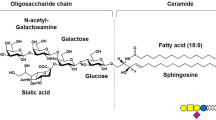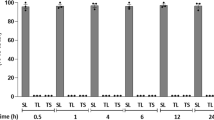Abstract
The influence of GM1 on the neuritogenic phase of neuronal differentiation has been highlighted in recent reports showing upregulation of this ganglioside in the plasma and nuclear membranes concomitant with axonogenesis. These changes are accompanied by alterations in Ca2+ flux which constitute an essential component of the signaling mechanism for axon outgrowth. This study examines 2 distinct mechanisms of induced neurite outgrowth involving plasma membrane GM1, as expressed in 3 neuroblastoma cell lines. Growth of Neuro-2a and NG108-15 cells in the presence of neuraminidase (N'ase), an enzyme that increases the cell surface content of GM1, caused prolific outgrowth of neurites which, in the case of Neuro-2a, could be blocked by the B subunit of cholera toxin (Ctx B) which binds specifically to GM1; however, the latter agent applied to NG108-15 cells proved neuritogenic and potentiated the effect of N'ase. With N18 cells, the combination was also neuritogenic as was Ctx B alone, whereas N'ase by itself had no effect. Neurite outgrowth correlated with influx of extracellular Ca2+, determined with fura-2. Treatment of NG108-15 and N18 cells with Ctx B alone caused modest but persistent elevation of intracellular Ca2+ while a more pronounced increase occurred with the combination Ctx B + N'ase. Treatment with N'ase alone also caused modest but prolonged elevation of intracellular Ca2+ in NG108-15 and Neuro-2a but not N18; in the case of Neuro-2a this effect was blocked by Ctx B. Neuro-2a and N18 thus possess 2 distinctly different mechanisms for neuritogenesis based on Ca2+ modulation by plasma membrane GM1, while NG108-15 cells show both capabilities. The neurites stimulated by N'ase + Ctx B treatment of N18 cells were shown to have axonal character, as previously demonstrated for NG108-15 cells stimulated in this manner and for Neuro-2a cells stimulated by N'ase alone.
Similar content being viewed by others
REFERENCES
Dreyfus, H., Louis, J. C., Harth, S., and Mandel, P. 1980. Gangliosides in cultured neurons. Neurosci. 5:1647–1655.
Ando, S. 1983. Gangliosides in the nervous system. Neurochem. Int. 5:507–537.
Yates A. J. 1986. Gangliosides in the nervous system during development and regeneration. Neurochem. Pathol. 5:309–329.
Skaper S. D., Leon A., and Toffano G. 1989. Ganglioside function in the development and repair of the nervous system. Mol. Neurol. 3:173–199.
Schengrund, C.-L. 1990. The role(s) of gangliosides in neural differentiation and repair: a perspective. Brain Res. Bull. 24:131–141.
Ledeen, R. W., and Wu, G. 1992. Ganglioside function in the neuron. Trend. Glycosci. Glycotechnol. 4:174–187.
Ferrari, G., Fabris, M., and Gorio, A. 1983. Gangliosides enhanced neurite outgrowth in PC12 cells. Devl. Brain Res. 8:215–221.
Katoh-Semba, R., Skaper, S. D., and Varon, S. 1984. Interaction of GM1 ganglioside with PC12 pheochromocytoma cells: serumand NGF-dependent effects on neurite growth (and proliferation). J. Neurosci. Res. 12:299–310.
Ledeen, R. W. 1984. Biology of gangliosides: neuritogenic and neuronotrophic properties. J. Neurosci. Res. 12:147–159.
Byrne M. C., Ledeen, R. W., Roisen, F. J., Yorke, G., and Sclafani, J. R. 1983. Ganglioside-induced neuritogenesis: verification that gangliosides are the active agents, and comparison of molecular species. J. Neurochem. 41:1214–1222.
Massarelli, R., Ferret, B., Gorio, A., Durand, M., and Dreyfus H. 1985. The effect of exogenous gangliosides on neurons in culture: A morphometric analysis. Int. J. Devl.Neurosci. 4:341–348.
Cannella, M. S., Roisen, F. J., Ogawa, T., Sugimoto, M., and Ledeen, R. W. 1988. Comparison of epi-GM3 with GM3 and GM1 as stimulators of neurite outgrowth. Devl. Brain Res. 39:137–143.
Cannella, M. S., Acher, M. S., and Ledeen, R. W. 1988. Stimulation of neurite outgrowth in vitro by a glycero-ganglioside. Int. J. Devl. Neurosci. 6:319–326.
Spirman, N., Sela, B. A., and Schwartz, M. 1982. Antigangliosides antibodies inhibit neuritic outgrowth from regenerating gold-fish retinal explants. J. Neurochem. 39:874–877.
Spirman, N., Sela, B.-A., Gilter, C., Calef, E., and Schwartz, M. 1984. Regenerative capacity of the goldfish visual system is affected by antibodies specific to gangliosides injected intracularly. J. Neuroimmunol. 6:197–207.
Wu, G., Nakamura, K., and Ledeen, R. W. 1994. Inhibition of neurite outgrowth of neuroblastoma Neuro-2A cells by cholera toxin B-subunit and anti-GM1 antibody. Mol. Chem. Neuropathol. 21:259–271.
Wu, G., Lu, Z.-H., and Ledeen, R. W. 1991. Correlation of gangliotetraose gangliosides with neurite forming potential of neuroblastoma cells. Devl. Brain Res. 61:217–228.
Dixon, S. J., Stewart, D., Grinstein, S., and Spiegel, S. 1987. Transmembrane signaling by the B subunit of cholera toxin: increased cytoplastomic free calcium in rat lymphocytes. J.Cell Biol. 105:1153–1161.
Spiegel, S., and Fishman, P. 1987. Gangliosides as bimodal regulators of cell growth. Proc. Natl. Acad. Sci. USA 84:141–145.
Gouy, H., Detterre, P., Debré, P., and Bismuth, G. 1994. Cell calcium signaling via GM1 cell surface gangliosides in the human Jurkat T cell line. J. Immunol. 152:3271–3281.
Milani, D., Minozzi, M.-C., Petrelli, L., Guidolin, D., Skaper, S. D., and Spoerri, P. E. 1992. Interaction of ganglioside GM1 with the B subunit of cholera toxin modulates intracellular free calcium in sensory neurons. J. Neurosci. Res. 33:446–475.
Marengo, F. D., Wang, S.-Y., Wang, B., and Langer, G. A. 1998. Dependence of cardiac cell Ca2??permeability on sialic acid-containing sarcolemmal gangliosides. J. Mol. Cell. Cardiol. 30: 127–137.
Wu, G., and Ledeen, R. W. 1991. Stimulation of neurite outgrowth in neuroblastoma cells by neuraminidase: putative role of GM1 ganglioside in differentiation. J. Neurochem. 56:95–104.
Masco, D., Van de Walle, M., and Spiegel, S. 1991. Interaction of ganglioside GM1 with the B subunit of cholera toxin modulates growth and differentiation of neuroblastoma N18 cells. J. Neurosci. 11:2443–2452.
Carlson, R. O., Masco, D., Brooker, G., and Spiegel, S. 1994. Endogenous ganglioside GM1 modulates L-type calcium channel activity in N18 neuroblastoma cells. J. Neurosci. 14:2272–2281.
Wu, G., and Ledeen, R. W. 1994. Gangliosides as modulators of neuronal calcium. Prog.Brain Res. 101:101–112.
Fang, Y., Wu, G., and Ledeen, R. W. 1995. Cellular mechanisms of endogenous GM1-involved neuritogenesis in neuroblastoma cells. J. Neurochem. 64 suppl.: S88 (Abstract).
Wu, G., Kozireski-Chubak, D. F., and Ledeen, R. W. 1999. Neuroblastoma cell differentiation and upregulation of nuclear GM1. J. Neurochem. 73 (suppl.):S167.
Wu, G., Fang, Y., Lu, Z.-H., and Ledeen, R. W. 1998. Induction of axon-like and dendrite-like processes in neuroblastoma cells. J. Neurocytol. 27:1–14.
Bottenstein, J. E., and Sato, G. H. 1979. Growth of a rat neuroblastoma cell line in serum-free supplemented medium. Proc. Natl. Acad. Sci. USA 76:514–517.
Piros, E. T., Prather, P. L., Loh, H. H., Law, P. Y., Evans, C. J., and Hales, T. G. 1995. Ca2+ channels and adenylyl cyclase modulation by cloned ?-receptors in GH3 cells. Mol. Pharmacol. 47:1041–1049.
Narahashi, T., Tsunoo, A., and Mitsunobu, Y. 1987. Characterization of two types of calcium channels in mouse neuroblastoma cells. J. Physiol. 383:231–249.
Quiroga, S., Panzetta, P., and Caputto, R. 1990. An endogenous inhibitor of N-acetylgalactosaminyltransferase inhibits retina neuron differentiation in culture. Brain Res. 508:337–340.
Conde, C. B., Grabois, V. R., Deza, S. N., and Caputto, B. L. 1997. Identification of an endogenous inhibitor of the UDP-N-acetylgalactosamine: GM3, N-acetylgalactosaminyl tranferase as apolipoprotein A1. Neurochem. Res. 22:483–490.
Furuya, S., Ono, K., and Hirabayashi, Y. 1995. Sphingolipid biosynthesis is necessary for dendrite growth and survival of cerebellar Purkinje cells in culture. J. Neurochem. 65:1551–1561.
Schwarz, A., Rapaport, E., and Futerman, A. H. 1995. A regulatory role for sphingolipids in neuronal growth. J. Biol. Chem. 270:10990–10998.
Uemura, K., Sugiyama, E., and Taketomi, T. 1991. Effect of an inhibitor of glucosylceramide synthase on glycosphingolipid synthesis and neurite outgrowth in murine neuroblastoma cell lines. J. Biochem. (Japan) 110:96–102.
Walsh, F. S., Skaper, S. D., and Doherty, P. 1994. Cell adhesion molecule (NCAM and N-cadherin)-dependent neurite outgrowth is modulated by gangliosides. Prog. Brain Res. 101:113–118.
Wu, G., Lu, Z.-H., Nakamura, K., Spray, D. C., and Ledeen, R. W. 1996. Trophic effect of cholera toxin B subunit in cultured cerebellar granule neurons: modulation of intracellular calcium by GM1 ganglioside. J. Neurosci. Res. 44:243–254.
Buckley, N. E., Su, Y., Milstien, A., and Spiegel, S. 1995. The role of calcium influx in cellular proliferation induced by interaction of endogenous ganglioside GM1 with the B subunit of cholera toxin. Biochim. Biophys. Acta 1256:275–283.
Ravichandra, B., and Joshi, P. G. 1999. Regulation of transmembrane signaling by ganglioside GM1: interaction of anti-GM1 with Neuro2a cells. J Neurochem. 73:557–567.
Langer, G. A., Frank, J. S., Nudd, L. M., and Seraydarian, K. 1976. Sialic acid: effect of removal on calcium exchangeability of cultured heart cells. Science 193:1013–1015.
Nathan, R. D., Fung, S. J., Stocco, D. M., Barron, E. A., and Markwald, R. R. 1980. Sialic acid: regulation of electrogenesis in cultured heart cells. Am. J. Physiol. 239:C197-C207.
Ledeen, R. W., Wu, G., Lu, Z. H., Kozireski-Chubak, D. F., and Fang, Y. 1998. The role of GM1 and other gangliosides in neuronal differentiation-Overview and new findings. Ann. N.Y. Acad. Sci. 845:161–175.
Alkon, D. L., and Rasmussen H. 1988. A spatial-temporal model of cell activation. Science 239:998–1004.
Wu, G., Vaswani, K. K., Lu, Z.-H., and Ledeen, R. W. 1990. Gangliosides stimulate calcium flux in Neuro-2A cells and require exogenous calcium for neuritogenesis. J. Neurochem. 55: 484–491.
. Isasi, S. C., Bianco, I. D., and Fidelio, G. D. 1995. Gangliosides raise the intracellular Ca2+ level in different cell types. Life Sci. 57:449–45.
Hilbush, B. S., and Levine, J. M. 1992. Modulation of a Ca2? signaling pathway by GM1 ganglioside in PC12 cells. J. Biol. Chem. 267:24789–24795.
De Erausquin, G. A., Manev, H., Guidotti, A., Costa, E., and Brooker, G. 1990. Gangliosides normalize distorted singlecell intracellular free Ca2+ dynamics after toxic doses of glutamate in cerebellar granule cells. Proc. Natl. Acad. Sci. USA 87:8017–8021.
Guerold, B., Massarelli, R., Forster, V., Freysz, L., and Dreyfus, H. 1992. Exogenous gangliosides modulate calcium fluxes in cultured neuronal cells. J. Neurosci. Res. 32:110–115.
Guan, Z., Stokes, B. T., Brocklyn, J. R. V., and Yates, A. J. 1992. Gangliosides inhibit platelet-derived growth-factor-stimulated increase in intracellular calcium in Swiss 3T3 cells. Biochim. Biophys. Acta 1136:315–318.
Nakamura, K., Wu, G., and Ledeen, R. W. 1992. Protection of Neuro-2a cells against calcium ionophore cytotoxicity by gangliosides. J. Neurosci. Res. 31:245–253.
Kozireski-Chubak, D. F., Wu, G., and Ledeen, R.W. 1999. Axonogenesis in Neuro-2a cells correlates with GM1 upregulation in the nuclear and plasma membranes. J. Neurosci. Res. 57: 541–550.
Wu, G., Lu, Z.-H., and Ledeen, R. W. 1995. Induced and spontaneous neuritogenesis associated with enhanced expression of ganglioside GM1 in the nuclear membrane. J Neurosci. 15:3739–3746.
Kozireski-Chubak, D. F., Wu, G., and Ledeen, R. W. 1999. Upregulation of nuclear GM1 accompanies axon-like, but not dendrite-like, outgrowth in NG108–15 cells. J. Neurosci. Res. 55:107–118.
Wu, G., Lu, Z.-H., and Ledeen, R. W. 1995. GM1 ganglioside in the nuclear membrane modulates nuclear calcium homeostasis during neurite outgrowth. J. Neurochem. 64:1419–1422.
Author information
Authors and Affiliations
Rights and permissions
About this article
Cite this article
Fang, Y., Wu, G., Xie, X. et al. Endogenous GM1 Ganglioside of the Plasma Membrane Promotes Neuritogenesis by Two Mechanisms. Neurochem Res 25, 931–940 (2000). https://doi.org/10.1023/A:1007596223484
Issue Date:
DOI: https://doi.org/10.1023/A:1007596223484




